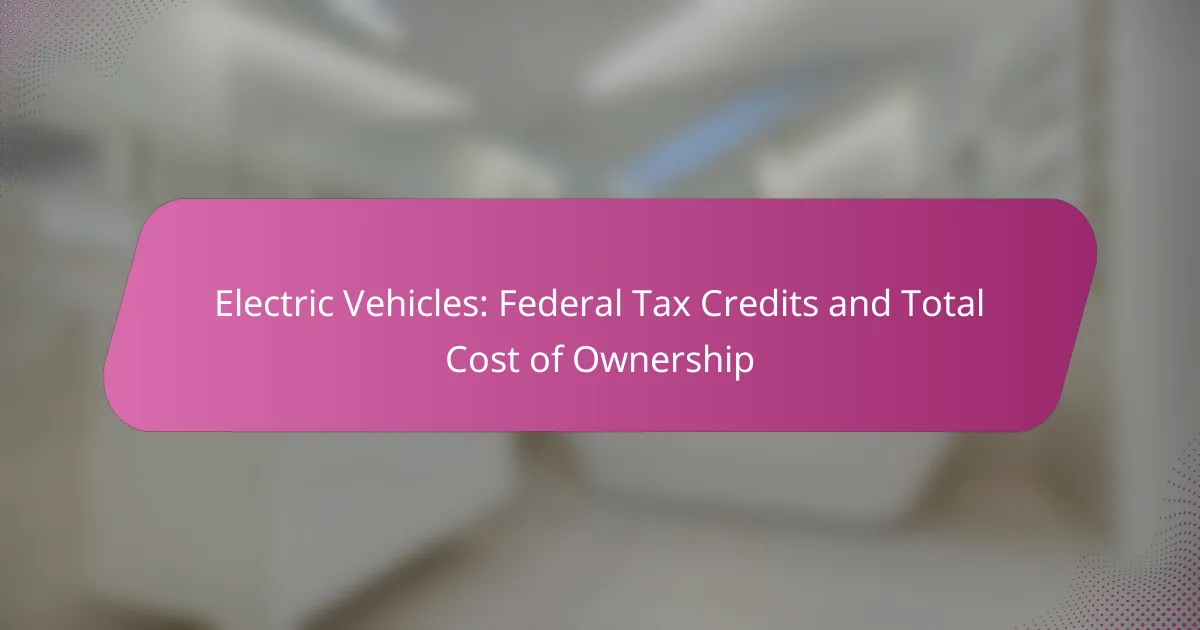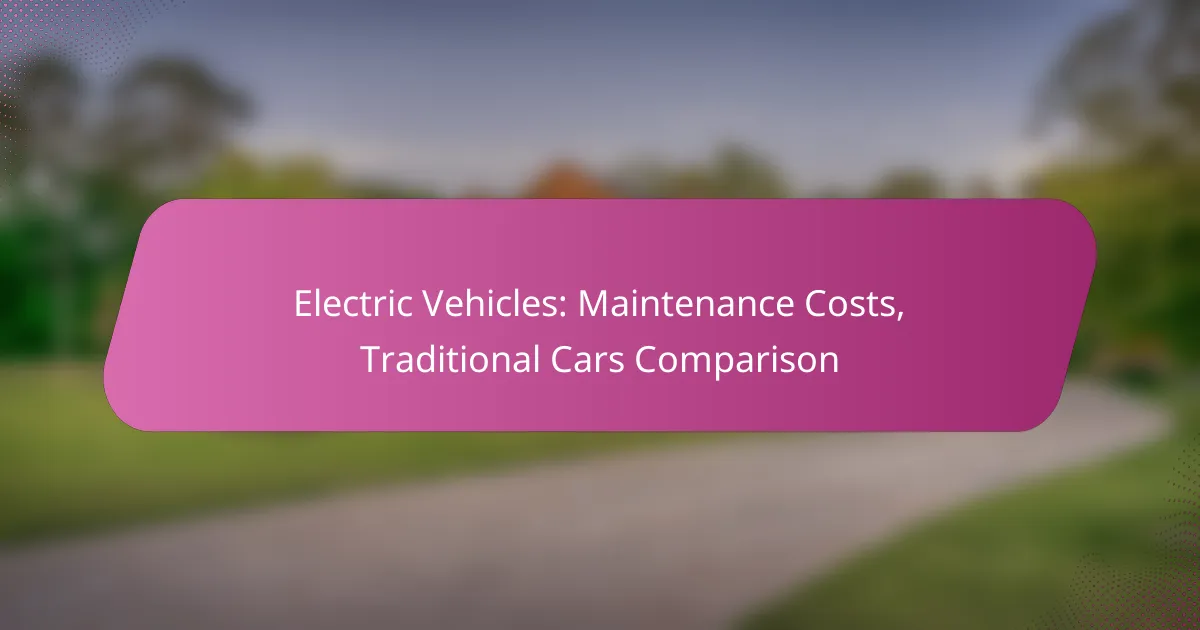State incentives play a crucial role in shaping consumer decisions regarding electric vehicle (EV) purchases. By offering financial benefits such as tax credits, rebates, and grants, these incentives lower the initial costs and enhance the appeal of EVs, making them a more attractive option for potential buyers. In states like California, such programs not only support individual consumers but also contribute to broader efforts to promote sustainable transportation and reduce environmental impact.
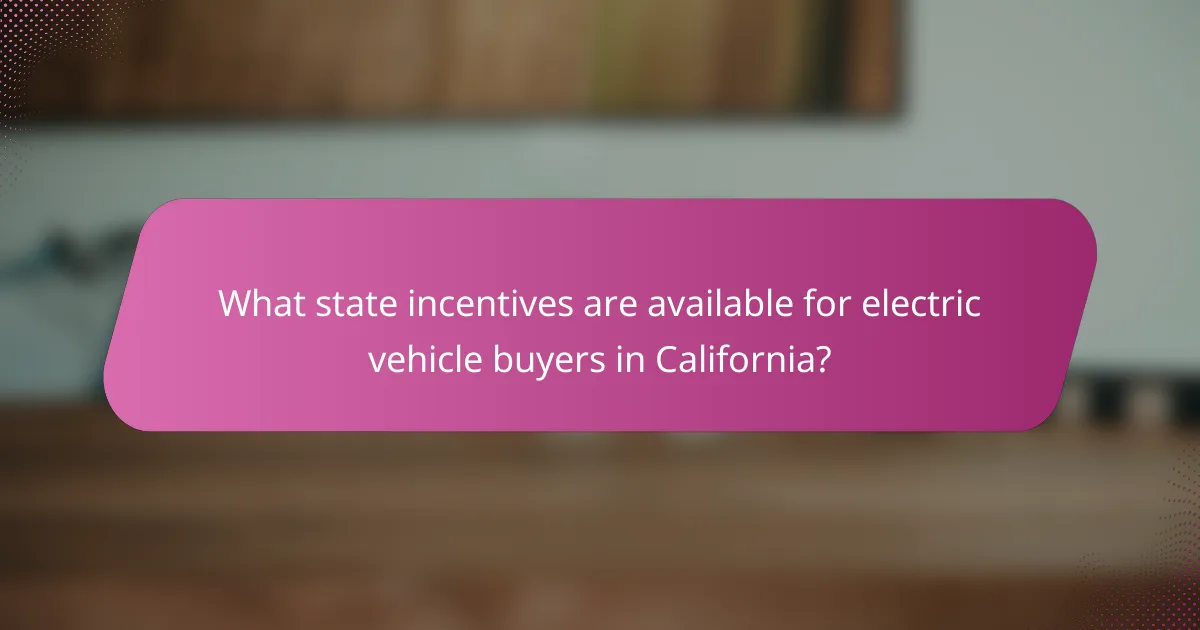
What state incentives are available for electric vehicle buyers in California?
California offers several incentives for electric vehicle (EV) buyers, aimed at reducing the overall cost of purchasing and operating an EV. These incentives include rebates, grants, and funding for infrastructure improvements to support EV adoption.
California Clean Vehicle Rebate Project
The California Clean Vehicle Rebate Project (CVRP) provides rebates to individuals and businesses that purchase or lease eligible electric vehicles. Depending on the vehicle type and the buyer’s income, rebates can range from a few thousand dollars to higher amounts for low-income applicants.
To qualify, buyers must apply for the rebate within 18 months of the purchase or lease date. It’s important to check the list of eligible vehicles and ensure that the application is submitted promptly to avoid missing out on the financial benefits.
California Electric Vehicle Infrastructure Project
The California Electric Vehicle Infrastructure Project (CALeVIP) focuses on expanding charging infrastructure throughout the state. This initiative offers funding to local governments, businesses, and organizations to install EV charging stations, making it easier for EV owners to charge their vehicles.
By participating in CALeVIP, stakeholders can receive financial support for the installation of charging equipment, which can significantly reduce the upfront costs. Interested parties should review the specific funding opportunities available in their region and consider applying to enhance local EV infrastructure.

How do state incentives impact electric vehicle purchase decisions?
State incentives significantly influence electric vehicle (EV) purchase decisions by reducing upfront costs and enhancing the overall value proposition for buyers. These incentives can take various forms, including tax credits, rebates, and grants, making EVs more financially accessible and attractive.
Increased affordability
State incentives directly increase the affordability of electric vehicles by lowering the initial purchase price. For example, many states offer tax credits that can range from a few thousand to over ten thousand dollars, depending on the vehicle and local regulations. This reduction can make EVs competitive with traditional gasoline vehicles, encouraging more consumers to consider them.
Additionally, some states provide rebates or grants that can be applied at the point of sale, further decreasing the financial burden on buyers. It’s essential for potential buyers to research the specific incentives available in their state, as these can vary widely and may change over time.
Enhanced resale value
State incentives can also enhance the resale value of electric vehicles, making them a more attractive long-term investment. Vehicles that qualify for incentives often maintain higher resale prices due to their perceived value and the ongoing demand for environmentally friendly options. Buyers are increasingly looking for vehicles that not only save on fuel costs but also have lower emissions.
Moreover, as more states implement stricter emissions regulations, the desirability of electric vehicles is likely to increase, further boosting their resale value. Buyers should consider how state incentives can impact not just the initial purchase but also the long-term value of their investment in an electric vehicle.
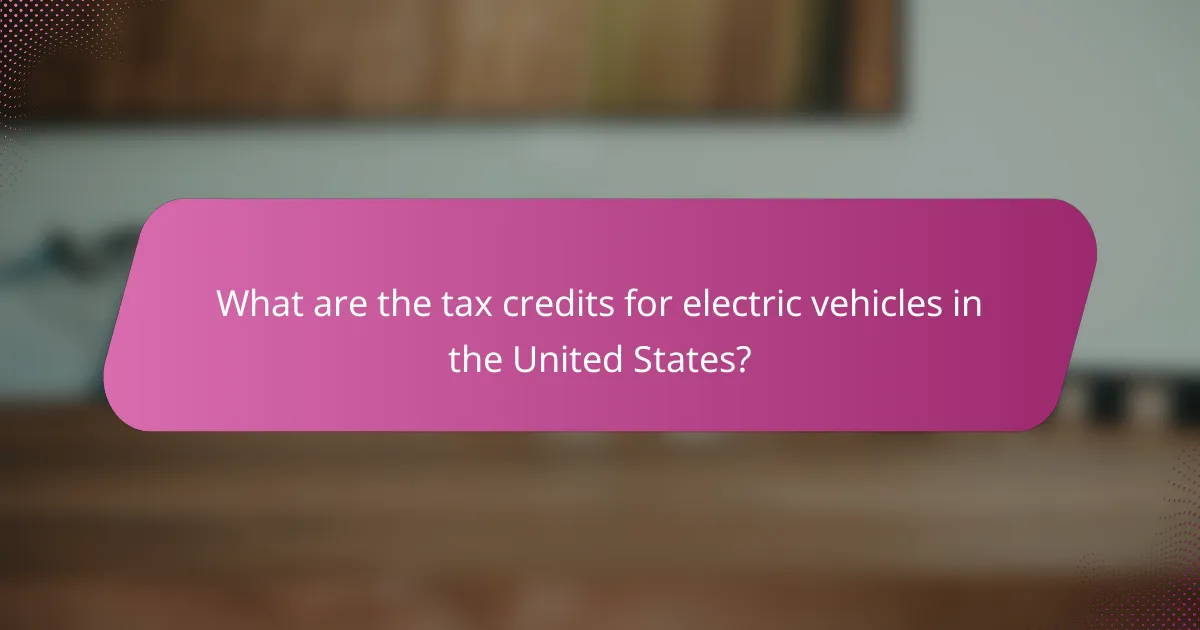
What are the tax credits for electric vehicles in the United States?
Tax credits for electric vehicles (EVs) in the United States are financial incentives designed to encourage the purchase of EVs. These credits can significantly reduce the overall cost of an electric vehicle, making them more accessible to consumers.
Federal EV Tax Credit
The federal EV tax credit offers up to $7,500 for qualifying electric vehicles purchased in the United States. The exact amount depends on the vehicle’s battery capacity and the manufacturer’s sales volume. To qualify, the vehicle must meet specific criteria set by the IRS, including being new and not exceeding a certain price threshold.
Buyers should be aware that the federal tax credit is non-refundable, meaning it can only reduce tax liability to zero but will not result in a refund. It’s advisable to consult a tax professional to understand how this credit applies to individual tax situations.
State-specific tax credits
Many states offer additional tax credits or rebates for electric vehicle purchases, which can vary widely in amount and eligibility criteria. For example, states like California and New York provide incentives that can range from a few hundred to several thousand dollars, depending on the vehicle and the buyer’s income level.
It’s essential to check the specific incentives available in your state, as some programs may have limited funding or specific deadlines. Websites like the U.S. Department of Energy’s Alternative Fuels Data Center can provide updated information on state-specific incentives.
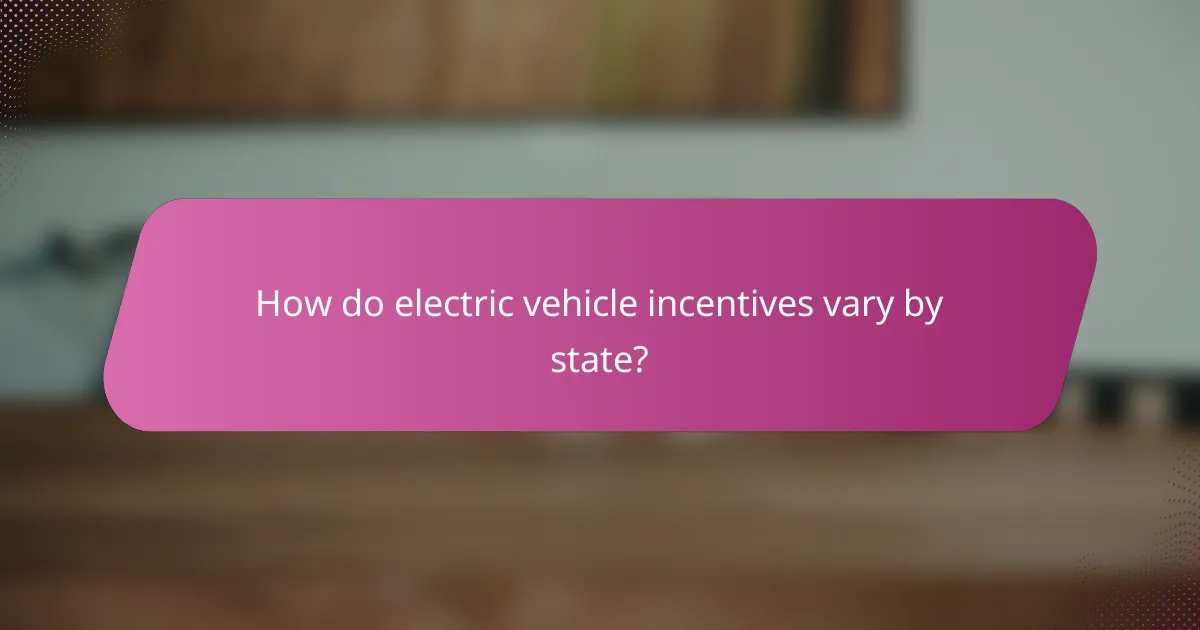
How do electric vehicle incentives vary by state?
Electric vehicle incentives differ significantly across states, impacting buyer decisions and overall adoption rates. These incentives can include tax credits, rebates, and grants, which vary in amount and eligibility based on local regulations and budgets.
Comparison of incentives in New York and Texas
New York offers one of the most robust electric vehicle incentive programs in the U.S., providing up to $2,000 in rebates for eligible electric vehicle purchases. Additionally, residents can benefit from a state tax credit that can further reduce the overall cost.
In contrast, Texas has a more modest approach, offering a rebate of up to $2,500 for electric vehicle buyers. While Texas does not have a state income tax, which can be advantageous for some buyers, the overall incentives are less comprehensive compared to New York.
Incentives in Florida vs. Washington
Florida provides a variety of incentives, including a rebate program that can offer up to $1,000 for electric vehicle purchases. Additionally, certain counties may have their own local incentives, enhancing the overall appeal for buyers in specific regions.
Washington state, on the other hand, has a strong focus on promoting electric vehicles through a sales tax exemption for purchases, which can save buyers significant amounts. The state also offers various grants and incentives for charging infrastructure, making it easier for residents to transition to electric vehicles.

What factors influence buyer decisions for electric vehicles?
Buyer decisions for electric vehicles (EVs) are primarily influenced by the cost of ownership and the availability of charging infrastructure. Understanding these factors can help potential buyers make informed choices that align with their needs and budgets.
Cost of ownership
The cost of ownership for electric vehicles includes the purchase price, maintenance costs, and potential savings on fuel. While EVs can have higher upfront costs compared to traditional vehicles, they often result in lower long-term expenses due to reduced maintenance and fuel costs.
Buyers should consider available incentives, such as federal tax credits or state rebates, which can significantly lower the initial purchase price. For instance, in the United States, federal tax credits can range from several thousand dollars, depending on the vehicle model and battery capacity.
Charging infrastructure availability
The availability of charging infrastructure is crucial for EV buyers, as it directly impacts the convenience of owning an electric vehicle. Buyers should assess the proximity of charging stations to their home, workplace, and frequently visited locations to ensure they can easily recharge their vehicles.
In urban areas, charging stations may be more prevalent, while rural regions might have limited options. Buyers can use apps or websites that map charging stations to evaluate their local infrastructure. Additionally, some homeowners may consider installing a home charging unit, which can provide added convenience and reduce reliance on public charging stations.
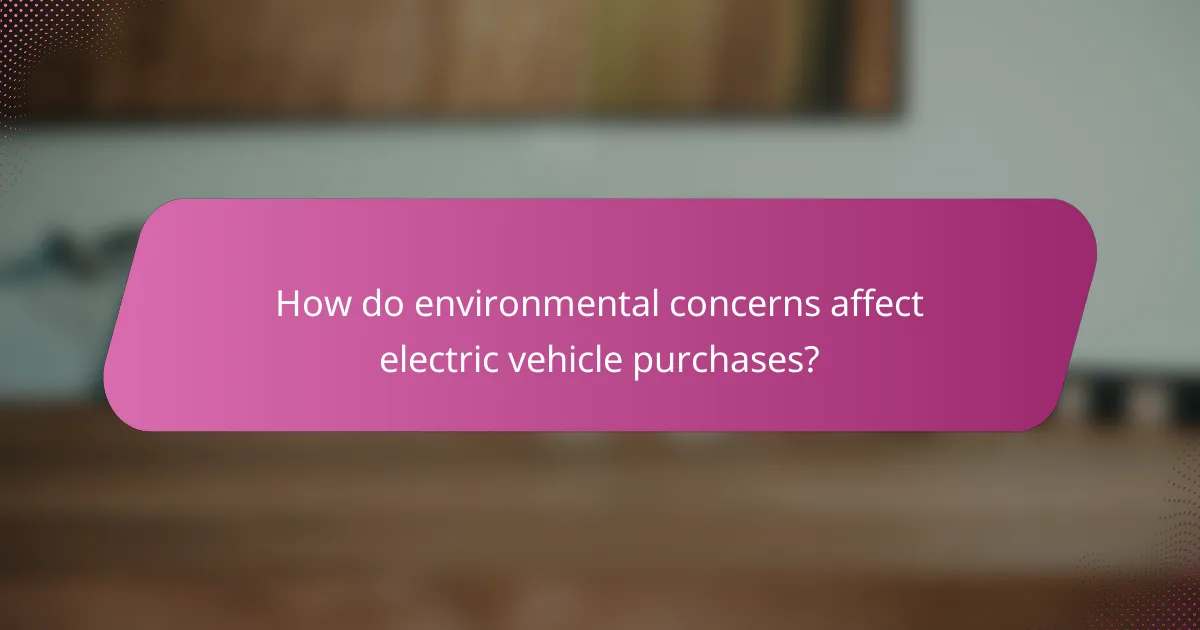
How do environmental concerns affect electric vehicle purchases?
Environmental concerns significantly influence electric vehicle (EV) purchases as consumers become more aware of the impact of traditional vehicles on air quality and climate change. Many buyers are motivated by the desire to reduce their carbon footprint and contribute to a more sustainable future.
Consumer awareness of emissions
As awareness of emissions and their harmful effects grows, consumers are increasingly seeking alternatives to fossil fuel-powered vehicles. Electric vehicles are often seen as a cleaner option, producing zero tailpipe emissions and contributing to improved air quality. This shift in consumer mindset is driving demand for EVs, especially in urban areas where pollution levels are a concern.
Educational campaigns and information from environmental organizations play a crucial role in shaping public perception. Many buyers now actively research vehicle emissions and consider the environmental impact of their purchases, making informed decisions that align with their values.
Impact of climate change on purchasing behavior
Climate change is a pressing issue that affects consumer behavior regarding vehicle purchases. Many individuals view the adoption of electric vehicles as a necessary step in combating climate change, leading to increased interest in EVs. This trend is particularly evident among younger generations who prioritize sustainability in their buying choices.
Additionally, government incentives and policies aimed at reducing greenhouse gas emissions further encourage the transition to electric vehicles. Programs offering tax credits, rebates, or grants for EV purchases can significantly sway buyer decisions, making electric vehicles more financially attractive.
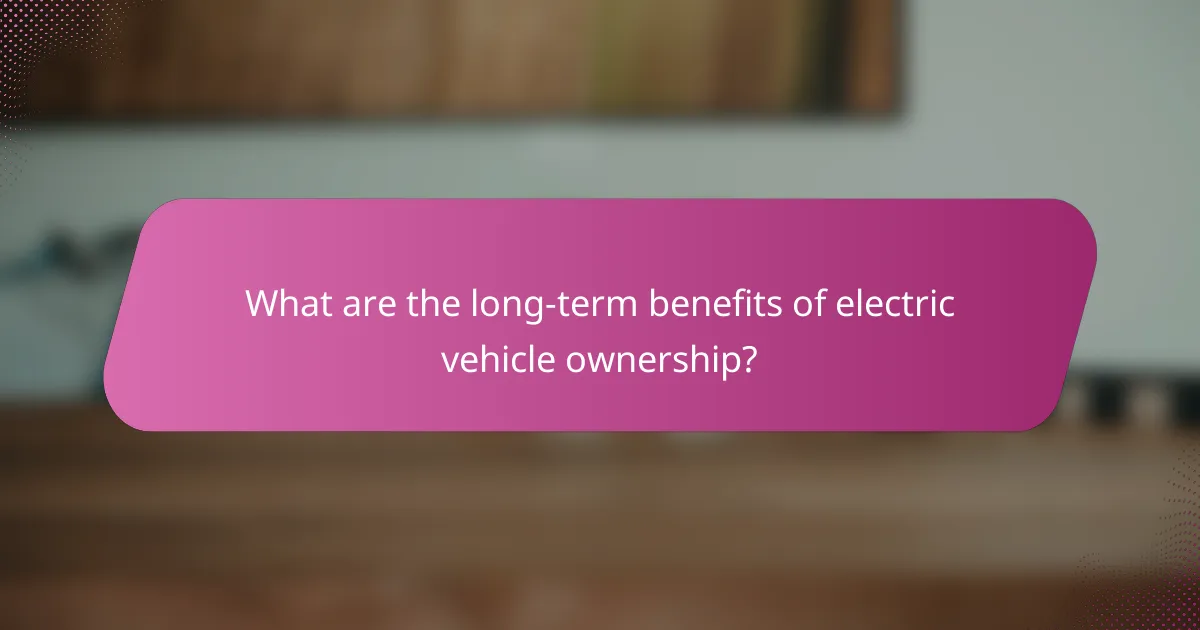
What are the long-term benefits of electric vehicle ownership?
Electric vehicle (EV) ownership offers several long-term benefits, including cost savings and environmental advantages. Over time, these benefits can significantly impact both personal finances and overall sustainability.
Lower maintenance costs
One of the primary advantages of owning an electric vehicle is the lower maintenance costs compared to traditional gasoline vehicles. EVs have fewer moving parts, which often results in reduced wear and tear, leading to lower repair expenses.
For instance, electric vehicles do not require oil changes, and brake wear is minimized due to regenerative braking systems. Owners can expect to save hundreds to thousands of dollars over the lifespan of the vehicle when compared to conventional cars.
Energy independence
Electric vehicle ownership can contribute to energy independence by reducing reliance on imported fossil fuels. By charging EVs with locally generated renewable energy, such as solar or wind, drivers can help support domestic energy sources.
Additionally, as the infrastructure for charging stations expands, more consumers will have access to convenient charging options, further promoting the use of renewable energy. This shift not only benefits individual owners but also enhances national energy security.

What emerging trends are shaping the electric vehicle market?
Emerging trends in the electric vehicle (EV) market include advancements in battery technology, increasing government incentives, and a growing focus on sustainability. These factors are influencing buyer decisions and shaping the future landscape of transportation.
Advancements in battery technology
Battery technology is rapidly evolving, leading to longer ranges and shorter charging times for electric vehicles. Innovations such as solid-state batteries and improved lithium-ion cells are expected to enhance performance significantly, making EVs more appealing to consumers.
For instance, many new models are now offering ranges exceeding 300 miles on a single charge, which alleviates range anxiety for potential buyers. Additionally, fast-charging capabilities are improving, with some vehicles able to charge to 80% in under 30 minutes.
Government incentives and regulations
Government incentives play a crucial role in promoting electric vehicle adoption. Many countries offer tax credits, rebates, and grants to lower the upfront costs of EVs, making them more accessible to a broader audience. In the United States, for example, federal tax credits can range from $2,500 to $7,500 depending on the vehicle’s battery capacity.
Moreover, various regions are implementing stricter emissions regulations, which encourage manufacturers to produce more electric models. Buyers should stay informed about local incentives, as these can significantly impact the overall cost of ownership.
Consumer preferences and sustainability
Consumer preferences are shifting towards environmentally friendly options, with many buyers prioritizing sustainability in their purchasing decisions. This trend is driving manufacturers to focus on eco-friendly materials and production processes, further enhancing the appeal of electric vehicles.
Additionally, the rise of shared mobility solutions and electric public transport options is influencing how consumers view personal vehicle ownership. As more people consider the environmental impact of their choices, the demand for electric vehicles is likely to continue growing.


